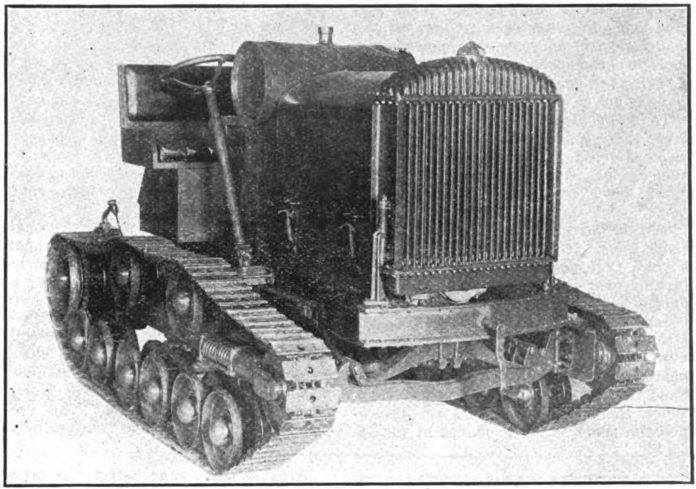After more than 30 years of digging into tractors and tractor history, I thought I had heard of most everything but then something new pops up.
While browsing through the May 1919 issue of Tractor World magazine, there was a photo of a Martin crawler tractor along with a story about it.
I immediately went to Charles Wendel’s tractor encyclopedia, and the Martin wasn’t listed!
Charles Hay Martin
Charles Hay Martin covered a lot of ground back in the day.
Born in 1867 in Findlay, Ohio, his first job was selling groceries wholesale.
He traveled Europe selling White chewing gum for a while, and then various products in this country.
In 1899, Charlie was bitten by the automobile bug and eventually ended up in Springfield, Massachusetts, working for the Knox Motor Co.
There, he designed a three-wheeled road tractor called the Knox-Martin that was one of the first truck tractors purpose-built to pull semi-trailers.
Herman Farr, another Knox employee, invented a gadget to connect a trailer to a truck tractor that was round in shape, with a tapered slot and locking mechanism for the trailer pin.
Its most important feature was that it rocked on hinges, allowing the trailer to follow on hilly or rough roads much better.
This tilting action plus the tapered slot also made one man connecting of truck to trailer much easier.
Martin saw the advantages of the fifth wheel and teamed with Farr to start the Martin Rocking Fifth Wheel Co., whose biggest customers became Fruehauf Trailer Co.
Charles Martin’s brother John patented a truck trailer about this time, and Charlie undertook to manufacture it.
However, Fruehauf, naturally, objected strongly and began work to develop their own improved fifth wheel.
By 1919, they were successful, and Martin and Farr lost their best customer.
During World War I, Martin had patented a full-tracked attachment for an automobile, but there’s no evidence it was ever produced.
Anyway, back to the Martin tractor.
Martin tractor
Apparently, anticipating the loss of Fruehauf as a large buyer of his fifth wheels, Martin decided he needed another product and settled on a crawler tractor.
The machine is the outcome of experimental work that Mr. Martin did with the Ordnance Department in Washington.
Standard truck components were used for the most part to construct the Martin tractor.
A four-cylinder Waukesha L-head engine of 4 1/4 by 5 1/2 inch displacement and a Brown-Lipe transmission, along with a Russel internal gear-drive differential, made up the tractor’s drive train.
No weight or horsepower is stated, just that the tractor was designed to pull three plows.
The radiator, which was built in-house, wasn’t soldered together as were most radiators, but the vertical tubes were held in place and sealed against leaks by steam packing material.
The track frame, which was attached to the tractor at both the front and rear by transverse leaf springs, bears no resemblance to Martin’s baby tank track.
Sprockets on the rear axle drove the tracks, which rode on six lower rollers, each of which was mounted on a sprung rocker arm so as to give when crossing an obstruction.
The front idler was provided with a spring tension member so that if a piece of rock or other debris came between the chain and sprocket, the track would simply move backward by action of the spring.
The rock will then follow the sprocket around until it falls out, when the spring will draw the track back into position on the sprocket.
I wonder how well this worked in practice.
As shown in the photo, instead of levers, the tractor was steered by means of a wheel, as was rather common on early crawlers.
No details are given about the steering arrangement, but the steering wheel probably applied a brake on the track on the side toward which it was desired to turn.
The lack of information about the Martin crawler tractor, and especially it not being listed in Wendel’s encyclopedia, leads me to believe that it probably never went into production, although I don’t know that for certain.
After WWI
Charlie Martin also tried his hand at the automobile business after the war.
He was financed in the venture by none other than Charles J. Glidden, originator of the Glidden Trophy that was awarded to the winner of the Glidden Tour — first run in 1904 and still run every year.
In 1921, Martin announced his new car, a tiny (60-inch wheelbase), aluminum bodied, two-passenger, three-wheeled runabout, that weighed just 150 pounds.
The Martin Scootmobile, as the wee vehicle was to be called, was powered by a two-cylinder, air-cooled engine, and the single front wheel was steered by a tiller.
A photo of the Scootmobile looks almost exactly like a three-wheeled golf cart.
Martin tinkered with the car, making many changes (another prototype was four-wheeled, and had a steel body and a Henderson motorcycle engine) and declared that the best of the prototypes would go into production in the spring of 1922.
In April, Martin declared the Scootmobile not yet ready for production, and, as it turned out, it never was.
Charles Hay Martin was one of the many colorful men who built the automobile industry in this country, although he never became a household name like Walter Chrysler or Henry Ford.













